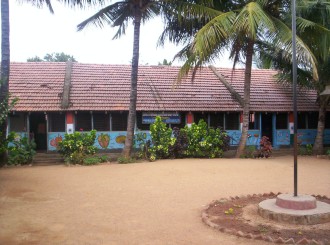It is ironical - and sad too - that the entire subject of Right to Education (RTE) has been hijacked by one issue: the reservation stipulated under the Act of 25 per cent of seats in private schools for neighbourhood children. In the context of solving the problems faced by the country in the field of education, nothing can be farther in terms of its relevance. Let us take the numbers that confront us, by taking an example.
One of the areas that Sikshana (www.sikshana.org) is active in is Kanakapura in Karnataka, southwest of Bangalore. Data from this taluk could provide reliable data, since it is located 60-100 kms from a metropolitan area, and is therefore neither urban nor 'too' rural. We could take the figures here to be broadly typical of what we might find across the country. Let's also look closely at only the high schools, where the aspirations for inclusion in the private stream are far higher than at lower levels.
Kanakapura has 34 government schools and 12 others that are government-aided, with a total strength of around 12,000 in Grades 8, 9 and 10. Against this, there are 17 private schools with a combined strength of 2500. All the private schools are not of the same caliber; there is a lot that distinguishes one from another, to the extent that many are well below the standards obtained routinely in state-run schools. Judging by their performance in the SSLC examinations - which is a benchmark in public perception - and the fee that they charge from the students, only three of these private schools may be classified as aspirational, and their combined strength works out to 750.
An explanation is due here for bringing in fee as a factor. If the amount is Rs.200 per month or lower, the parents do not need the crutches of the Act to admit their children in private schools; it is only when this starts going higher, typically in the range of Rs.5000 or more per annum, that one can expect parents to press for accommodation under the quota prescribed in the Act.
From the above, one can see that the total number of 'aspirational' high school seats in the taluk, assessed at 25 per cent of their strength as provided in the Act, works out to less than 200. Whereas, as noted earlier, there are 12,000 students in the public education system in high school. This is a two per cent satisfaction level at best. The state-run Navodaya schools with their excellent record offer a far better option for the students in the targeted category, both in terms of quality and numbers.
It is true that in the urban environment, as in Bangalore city itself, the seats in this category will be far higher, but it is equally true that in very remote areas there are no private schools at all, and taken together the state-wide average of aspirational seats available may not be more than 5 per cent. It is obvious, given these numbers, that the private stream does not offer a viable solution - either through direct absorption or through the reservation quota - to educating the large number of children knocking at the doors of the State.
A vicious and vigorous thrust is being given by the interested lobbies to denigrate the public education system and promote the private stream as the solution for the future. In the process, Public-Private Partnerships (PPPs) are touted as a magic panacea for our ills, ignoring the simple fact that no developed country has so far been able to get away without a healthy public school system. Good private schools have their own place in the scheme of things, especially for those who seek excellence and can afford them. However in no case have private schools emerged as an alternate to the public schools.

A vicious and vigorous thrust is being given by the interested lobbies to denigrate the public education system and promote the private stream as the solution for the future.

•
Imperiling public education
•
Unlearning the untruths
•
Focus on learning outcomes
The current Indian version is more akin to bussing (transporting children from poor areas to better schools in richer neighbourhoods), which was tried out in the United States, and whose failure was widely documented. It takes care neither of the system itself, nor of the children whose interests it is supposed to serve.
To me, RTE looks more like an effort on the part of the middle classes to effect a back door entry into the portals of premium schools. After all it is they who are most likely to be available at the right place for making a claim under the quota and obtain use the provisions of the Act. The small print in the Act intended to avoid such misuse is not going to deter them from doing it; there are enough precedents in support of this conclusion.
If and when this happens, it will not be the first time that the politically active middle classes usurp the benefits offered by the State under a
legislation, purportedly designed for the deprived sections of the society. The aam aadmi has always been a useful figure in whose name various
claims can be made, even as the country studiously ignores him in policy and practice.























